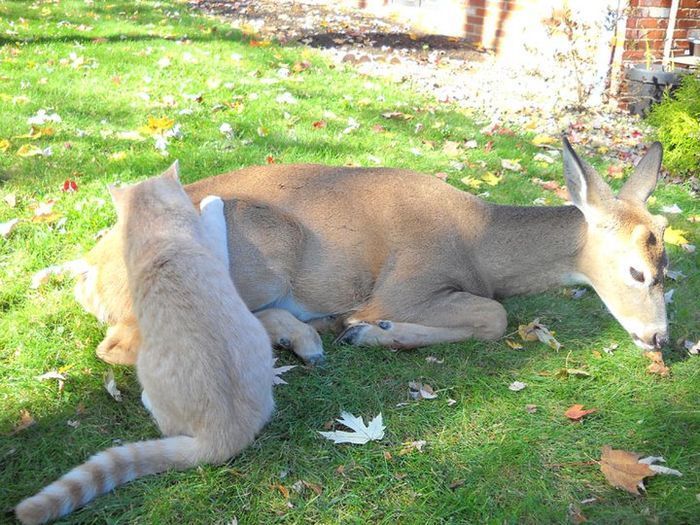Cat And A Little Deer
|
Deer live in a variety of biomes ranging from tundra to the tropical rainforest. While often associated with forests, many deer are ecotone species that live in transitional areas between forests and thickets (for cover) and prairie and savanna (open space). The majority of large deer species inhabit temperate mixed deciduous forest, mountain mixed coniferous forest, tropical seasonal/dry forest, and savanna habitats around the world. Clearing open areas within forests to some extent may actually benefit deer populations by exposing the understory and allowing the types of grasses, weeds, and herbs to grow that deer like to eat. Additionally, access to adjacent croplands may also benefit deer. However, adequate forest or brush cover must still be provided for populations to grow and thrive.
Small species of brocket deer and pudús of Central and South America, and muntjacs of Asia generally occupy dense forests and are less often seen in open spaces, with the possible exception of the Indian Muntjac. There are also several species of deer that are highly specialized, and live almost exclusively in mountains, grasslands, swamps, and "wet" savannas, or riparian corridors surrounded by deserts. Some deer have a circumpolar distribution in both North America and Eurasia. Examples include the caribou that live in Arctic tundra and taiga (boreal forests) and moose that inhabit taiga and adjacent areas. Huemul Deer (taruca and Chilean Huemul) of South America's Andes fill an ecological niche of the ibex or Wild Goat, with the fawns behaving more like goat kids.
The highest concentration of large deer species in temperate North America lies in the Canadian Rocky Mountain and Columbia Mountain Regions between Alberta and British Columbia where all five North American deer species (White-tailed deer, Mule deer, Caribou, Elk, and Moose) can be found. This region has several clusters of national parks including Mount Revelstoke National Park, Glacier National Park (Canada), Yoho National Park, and Kootenay National Park on the British Columbia side, and Banff National Park, Jasper National Park, and Glacier National Park (U.S.) on the Alberta and Montana sides. Mountain slope habitats vary from moist coniferous/mixed forested habitats to dry subalpine/pine forests with alpine meadows higher up. The foothills and river valleys between the mountain ranges provide a mosaic of cropland and deciduous parklands. The rare woodland caribou have the most restricted range living at higher altitudes in the subalpine meadows and alpine tundra areas of some of the mountain ranges. Elk and Mule Deer both migrate between the alpine meadows and lower coniferous forests and tend to be most common in this region. Elk also inhabit river valley bottomlands, which they share with White-tailed deer. The White-tailed deer have recently expanded their range within the foothills and river valley bottoms of the Canadian Rockies owing to conversion of land to cropland and the clearing of coniferous forests allowing more deciduous vegetation to grow up the mountain slopes. They also live in the aspen parklands north of Calgary and Edmonton, where they share habitat with the moose. The adjacent Great Plains grassland habitats are left to herds of Elk, American Bison, and pronghorn antelope.
The Eurasian Continent (including the Indian Subcontinent) boasts the most species of deer in the world, with most species being found in Asia. Europe, in comparison, has lower diversity in plant and animal species. However, many national parks and protected reserves in Europe do have populations of Red Deer, Roe Deer, and Fallow Deer. These species have long been associated with the continent of Europe, but also inhabit Asia Minor, the Caucasus Mountains, and Northwestern Iran. "European" Fallow Deer historically lived over much of Europe during the Ice Ages, but afterwards became restricted primarily to the Anatolian Peninsula, in present-day Turkey. Present-day Fallow deer populations in Europe are a result of historic man-made introductions of this species first to the Mediterranean regions of Europe, then eventually to the rest of Europe. They were initially park animals that later escaped and reestablished themselves in the wild. Historically, Europe's deer species shared their deciduous forest habitat with other herbivores such as the extinct tarpan (forest horse), extinct aurochs (forest ox), and the endangered wisent (European bison). Good places to see deer in Europe include the Scottish Highlands, the Austrian Alps, and the wetlands between Austria, Hungary, and Czech Republic. Some fine National Parks include Doñana National Park in Spain, the Veluwe in the Netherlands, the Ardennes in Belgium, and Białowieża National Park of Poland. Spain, Eastern Europe, and the Caucasus Mountains still have virgin forest areas that are not only home to sizable deer populations but also for other animals that were once abundant such as the wisent, Eurasian Lynx, Spanish lynx, wolves, and Brown Bears.
|
|









